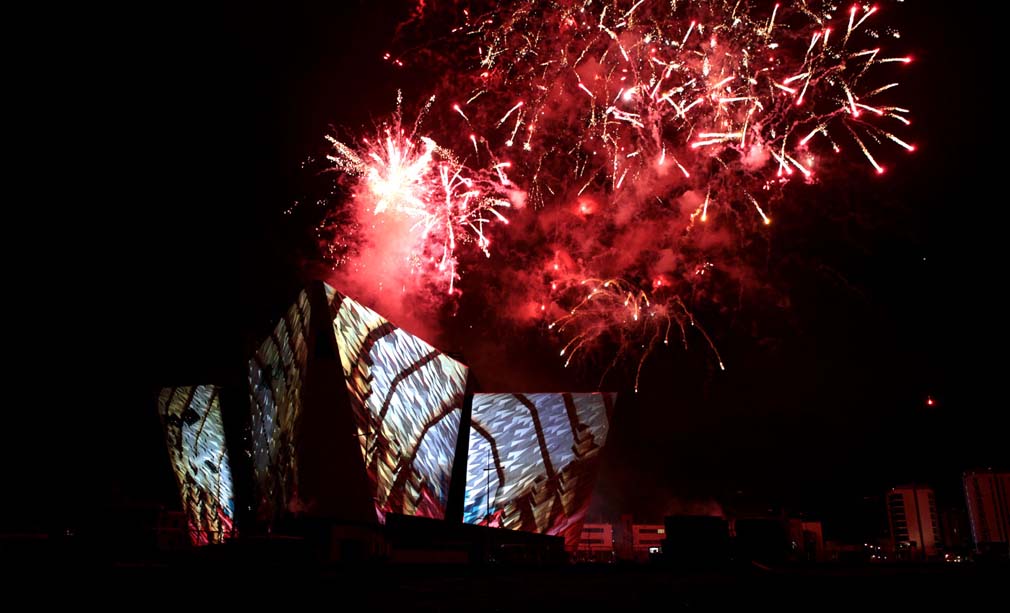Projection Mapping is perhaps best known for creating jaw-dropping shows on large-scale building facades. The seeper team created the UK's first ever projection mapped installation at the Branchage Film and Music Festival and have since created a series of awe inspiring spectacles at places like Belfast's Titanic Visitors Centre, Rochester Castle and a live event on the Television Centre, London for the BBC.
Projection mapping is a technique to precisely match pre-recorded or live, interactive footage to real-world architecture and geometry.
It is not just limited to static scenery, but can also be used to track moving targets such as doors, mechanisms, vehicles and even people and animals. In essence, it projects a layer of extended reality that reflects, enhances and even subverts the forms over which it is cast.

In order for this process to work we need to fully understand the forms over which the projection is placed. This could be geometry we build ourselves, or it could be an existing space, model or building exterior.
In such cases we use LIDAR mapping, photogrammetry, precise measurements or a combination of all of these to create an accurate digital model of the target area.
We use this as a basis to frame the content, ensuring that it will match the forms exactly, and also as a means to make exacting calculations on the placement, coverage and brightness of the projectors.

The content itself can come from any number of sources, from filmed footage to entirely digitally generated imagery.
However it is sourced, it is thoughtfully and artistically combined with the digital target model to ensure that the final output makes full use of the physical surfaces.
Once completed, our installation teams mount the projectors at precisely calculated locations and ensure that everything is mapped to pixel perfection using sophisticated tools.
Content is shared across multiple projectors - sometimes large numbers of them - which are synchronised from a central media server.

It can also be combined to create dynamic backdrops for theatre or dance, replacing the need to stop the show to change sets.
Good examples of this can be seen in our previous projects like Mandala, the Vimeo Awards Show and the Festival of Media Awards.

With large-scale projections, the audience is largely looking from a single, controlled point of view, smaller models use projection-mapping in a different way, encouraging viewers to move around the model and interact with it.
This can bring dynamic elements and special effects to otherwise static dioramas.
Three superb examples of this are the state-of-the-art sales suite at One Canada Square featuring a fully interactive, projection-mapped scale model of the Canary Wharf development, the special effects enhancements created especially for Little Big City: Beijing and the ocean creatures brought to life for Sea Life: Sydney, including a projection-mapped sea-turtle beach show.

It is used to integrate with the actors themselves, creating scenarios otherwise impossible to render, such as car chases or burning buildings, as in Gangsta Granny at Alton Towers.
Additionally it can enable characters that otherwise would be absent, such as comic ogres and cartoonish cats (among others). Great examples of this can be seen in Room on the Broom, Shrek's Adventure and Treetop Adventure Golf in Birmingham.

Finally, it can be utilised as a type of information-based augmented reality in forms such as head-up data displays or dynamic wayfinding solutions in public buildings.
Projected information can be placed over treated, transparent surfaces to provide additional detail to naturalistic views and vistas, perhaps revealing the history of a battlefield or stately home. A good examples of this system in use includes Kingsmall Shopping Centre.

Case study
Iron Man v ACDC
Battle of Brachage
Sain Audio Reactive
Titanic 100
Wings of Desire
SeeCity Canary Wharf
Gangsta Granny Dark Ride
Little Big Beijing
Festival of Media Awards
Ewerk
Asian Winter Games
Press Coverage:
Want to talk about your idea or attraction?
Get in touch: hello@seeper.com
Related solutions:
Brand Anniversaries and Special Occasions








